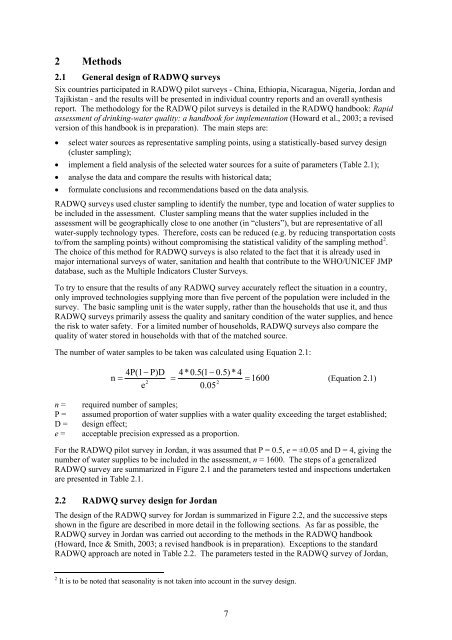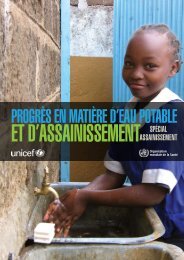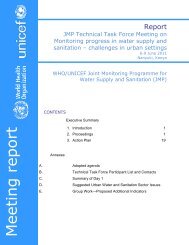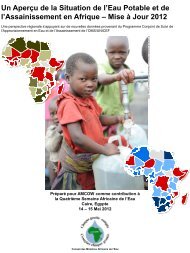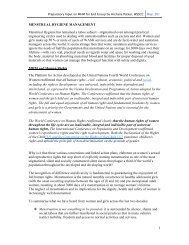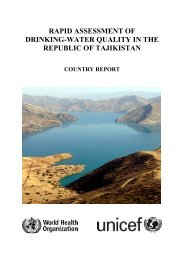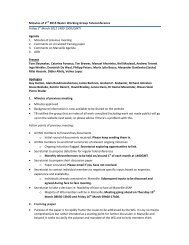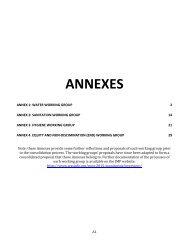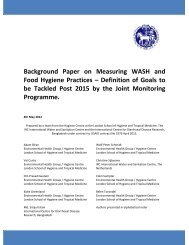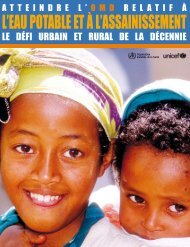Rapid assessment of drinking-water quality in the - WHO/UNICEF ...
Rapid assessment of drinking-water quality in the - WHO/UNICEF ...
Rapid assessment of drinking-water quality in the - WHO/UNICEF ...
You also want an ePaper? Increase the reach of your titles
YUMPU automatically turns print PDFs into web optimized ePapers that Google loves.
2 Methods<br />
2.1 General design <strong>of</strong> RADWQ surveys<br />
Six countries participated <strong>in</strong> RADWQ pilot surveys - Ch<strong>in</strong>a, Ethiopia, Nicaragua, Nigeria, Jordan and<br />
Tajikistan - and <strong>the</strong> results will be presented <strong>in</strong> <strong>in</strong>dividual country reports and an overall syn<strong>the</strong>sis<br />
report. The methodology for <strong>the</strong> RADWQ pilot surveys is detailed <strong>in</strong> <strong>the</strong> RADWQ handbook: <strong>Rapid</strong><br />
<strong>assessment</strong> <strong>of</strong> <strong>dr<strong>in</strong>k<strong>in</strong>g</strong>-<strong>water</strong> <strong>quality</strong>: a handbook for implementation (Howard et al., 2003; a revised<br />
version <strong>of</strong> this handbook is <strong>in</strong> preparation). The ma<strong>in</strong> steps are:<br />
select <strong>water</strong> sources as representative sampl<strong>in</strong>g po<strong>in</strong>ts, us<strong>in</strong>g a statistically-based survey design<br />
(cluster sampl<strong>in</strong>g);<br />
implement a field analysis <strong>of</strong> <strong>the</strong> selected <strong>water</strong> sources for a suite <strong>of</strong> parameters (Table 2.1);<br />
analyse <strong>the</strong> data and compare <strong>the</strong> results with historical data;<br />
formulate conclusions and recommendations based on <strong>the</strong> data analysis.<br />
RADWQ surveys used cluster sampl<strong>in</strong>g to identify <strong>the</strong> number, type and location <strong>of</strong> <strong>water</strong> supplies to<br />
be <strong>in</strong>cluded <strong>in</strong> <strong>the</strong> <strong>assessment</strong>. Cluster sampl<strong>in</strong>g means that <strong>the</strong> <strong>water</strong> supplies <strong>in</strong>cluded <strong>in</strong> <strong>the</strong><br />
<strong>assessment</strong> will be geographically close to one ano<strong>the</strong>r (<strong>in</strong> “clusters”), but are representative <strong>of</strong> all<br />
<strong>water</strong>-supply technology types. Therefore, costs can be reduced (e.g. by reduc<strong>in</strong>g transportation costs<br />
to/from <strong>the</strong> sampl<strong>in</strong>g po<strong>in</strong>ts) without compromis<strong>in</strong>g <strong>the</strong> statistical validity <strong>of</strong> <strong>the</strong> sampl<strong>in</strong>g method 2 .<br />
The choice <strong>of</strong> this method for RADWQ surveys is also related to <strong>the</strong> fact that it is already used <strong>in</strong><br />
major <strong>in</strong>ternational surveys <strong>of</strong> <strong>water</strong>, sanitation and health that contribute to <strong>the</strong> <strong>WHO</strong>/<strong>UNICEF</strong> JMP<br />
database, such as <strong>the</strong> Multiple Indicators Cluster Surveys.<br />
To try to ensure that <strong>the</strong> results <strong>of</strong> any RADWQ survey accurately reflect <strong>the</strong> situation <strong>in</strong> a country,<br />
only improved technologies supply<strong>in</strong>g more than five percent <strong>of</strong> <strong>the</strong> population were <strong>in</strong>cluded <strong>in</strong> <strong>the</strong><br />
survey. The basic sampl<strong>in</strong>g unit is <strong>the</strong> <strong>water</strong> supply, ra<strong>the</strong>r than <strong>the</strong> households that use it, and thus<br />
RADWQ surveys primarily assess <strong>the</strong> <strong>quality</strong> and sanitary condition <strong>of</strong> <strong>the</strong> <strong>water</strong> supplies, and hence<br />
<strong>the</strong> risk to <strong>water</strong> safety. For a limited number <strong>of</strong> households, RADWQ surveys also compare <strong>the</strong><br />
<strong>quality</strong> <strong>of</strong> <strong>water</strong> stored <strong>in</strong> households with that <strong>of</strong> <strong>the</strong> matched source.<br />
The number <strong>of</strong> <strong>water</strong> samples to be taken was calculated us<strong>in</strong>g Equation 2.1:<br />
4P(1<br />
P)D 4 * 0.5(1 0.5) * 4<br />
n 1600<br />
(Equation 2.1)<br />
2<br />
2<br />
e<br />
0.05<br />
n =<br />
P =<br />
D =<br />
e =<br />
required number <strong>of</strong> samples;<br />
assumed proportion <strong>of</strong> <strong>water</strong> supplies with a <strong>water</strong> <strong>quality</strong> exceed<strong>in</strong>g <strong>the</strong> target established;<br />
design effect;<br />
acceptable precision expressed as a proportion.<br />
For <strong>the</strong> RADWQ pilot survey <strong>in</strong> Jordan, it was assumed that P = 0.5, e = ±0.05 and D = 4, giv<strong>in</strong>g <strong>the</strong><br />
number <strong>of</strong> <strong>water</strong> supplies to be <strong>in</strong>cluded <strong>in</strong> <strong>the</strong> <strong>assessment</strong>, n = 1600. The steps <strong>of</strong> a generalized<br />
RADWQ survey are summarized <strong>in</strong> Figure 2.1 and <strong>the</strong> parameters tested and <strong>in</strong>spections undertaken<br />
are presented <strong>in</strong> Table 2.1.<br />
2.2 RADWQ survey design for Jordan<br />
The design <strong>of</strong> <strong>the</strong> RADWQ survey for Jordan is summarized <strong>in</strong> Figure 2.2, and <strong>the</strong> successive steps<br />
shown <strong>in</strong> <strong>the</strong> figure are described <strong>in</strong> more detail <strong>in</strong> <strong>the</strong> follow<strong>in</strong>g sections. As far as possible, <strong>the</strong><br />
RADWQ survey <strong>in</strong> Jordan was carried out accord<strong>in</strong>g to <strong>the</strong> methods <strong>in</strong> <strong>the</strong> RADWQ handbook<br />
(Howard, Ince & Smith, 2003; a revised handbook is <strong>in</strong> preparation). Exceptions to <strong>the</strong> standard<br />
RADWQ approach are noted <strong>in</strong> Table 2.2. The parameters tested <strong>in</strong> <strong>the</strong> RADWQ survey <strong>of</strong> Jordan,<br />
2 It is to be noted that seasonality is not taken <strong>in</strong>to account <strong>in</strong> <strong>the</strong> survey design.<br />
7


